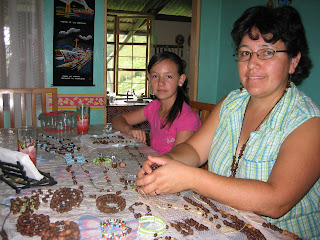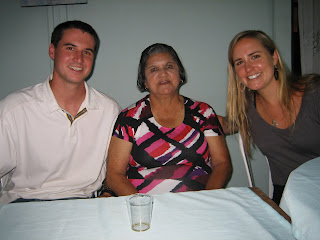
Empanadas de Chiverre:
Anís and Ananías
In true tica fashion I am delivering this recipe for Empanadas de Chiverre late, late, late (my scribbled notes on how to make it are from April 1, 2010). I must admit that the only reason this is even being posted is a sore throat/head cold has my whole host family and me at home (last night was spent with five of us in bed coughing and watching Harry Potter IV).
My host-abuela makes amazing bread and pastries, including an empanada filled with miel de chiverre, a molasses/dulce sweetened and slow cooked fruit, similar to spaghetti squash. The ingredient for this post is the spice
Anís or Anise
, used in the dough. I am rather new to using anise, so please respond with any other ways you've included it in your cooking (or just any response will do)!
Empanadas de Chiverre
The measurements on this are estimates- it was more of a guess and check until the dough looked like dough
Chiverre or spaghetti squash
2 cups molasses (dulce)
2 cups flour (would love to try substituting with whole wheat flour…)
6 spoon fulls of sugar
1 stick of butter
1/2 cup Milk
2 Eggs
Pinch of Anise
Pinch of salt
For the miel de chiverre, cut and seed the chiverre. Cook the chiverre along with the molasses in a soup pot for about two hours. Directions are limited as my host-abuela always has the miel de chiverre on hand, and I get the feeling she's keeping the recipe a bit of un secreto. However, many websites give a simple recipe.
To make the dough: mix the flour, sugar and butter and mold it into the shape of a volcán and pour the eggs and milk into the hole. Mix with your hands until all dry ingredients are incorporated, adding more milk as necessary. Toss in the anise and salt, and continue kneading the dough.
When the dough is ready, separate into fist-size balls and flatten into pancakes. The miel de chiverre will go inside, and you can close the empanadas by pinching the outsides of the dough into half-moons. Here comes the tricky part: in the wood oven it took about 15 minutes for the empanadas to be finished, which should be about 15 minutes at 350 degrees.
Now that something yummy is in the oven...
A major draw-back of being so delayed in my posts is that all the excitement and anticipation of the last weeks/months is lost. Two weeks ago we found out our site placements, drum roll please, I will be living in San Cristóbal Norte, a beautiful, hard-working mountain pueblo of 300 families in the central valley of Costa Rica.
Even though all the volunteer sites sound pura vida, I couldn’t imagine a better home for the next two years. I will be filling the spot of a previous Peace Corps volunteer, Blake, who also happened to live in my same training community, Tarbaca, two years ago. To stick with the theme of the blog I've composed a recipe for my new home:
San Cristóbal Norte
1 Ananías (the name of my counterpart, or main support, also the community bank president- not to be confused with anís previously used to cook empanadas de chiverre)
2 cups cold mountain air
2 short/easy bus rides from San Jose, Costa Rica (perfect for visitors!)
A whole bunch of coffee and chive farmers
1 beautiful, yellow catholic church in the center of town
2 Rural tourism organizations, bringing University volunteers from Australia, Canada and USA (I will begin helping them build a road and later a water tank as soon as I move to my site)
19 Intermediate-level English students, eager to continue classes
1 trout “sport” fishing farm- (another ingredient to pull blog readers to visit)
Mix the above ingredients with youth enthusiastic about young-business programs, library books waiting to be cataloged and a library waiting to be completed- two full Harry Potter sets in Spanish, but please contact me if you have any more Spanish/English books to add!, and arguably one of the strongest micro-banks in Costa Rica (retreats for other banks are often held in my town). Add general coaching for local micro-entrepreneurs, a potential girls soccer team and the most caring, considerate community and San Cristobal Norte is almost complete. Sprinkle the proximity to my current training-community host family and a strong focus on the environment and you have my perfect site!
Below are a handful of photos to elaborate:

My new host sister Marianna and me with chive fields in the background.
My new host dad, Don Geraldo (last host grandpa was also Don Geraldo, but story gets better- my new host dad used to date my old host grandma!) making some cheese...hoping it will be a real crowd-cheeser.
The volunteer I am replacing, Blake, his host mom and me in the local Bank/ECC, my counterpart. The first night I arrived was a going away dinner for Blake, combined with a welcome for me, all major organizations in the community were represented.
We visited my future site about a month ago for a technical visit, above is a photo of our group in front of a micro-entrepreneur's project of hydroponic lettuce. The same couple are looking to open a wood-museum in the future, a potential project!
Hiking in my new backyard! Although it is difficult to find flat ground to run on, the hills equal amazing views.
My host sister at the semana santa processions near Cartago. I have now visited my host-dad's family in Cartago a few times (most recently for a quincinera and wild amusement park) and am looking forward to having a second home there as it is less than 15 minutes from my new site.
.JPG) My host sister Marianna (current Marianna, next host sister is Marianna 2) showing off her helado in the pulperia during semana santa
My host sister Marianna (current Marianna, next host sister is Marianna 2) showing off her helado in the pulperia during semana santa
The PC volunteer who lived in my house two years ago, Kayla (who has since returned to the states), my host mom (one eye shut, she'd kill me if she knew this was the photo I posted), my host grandma, cousin and sister in the kitchen






















































.JPG)
